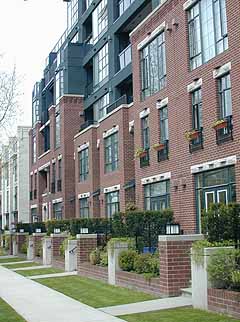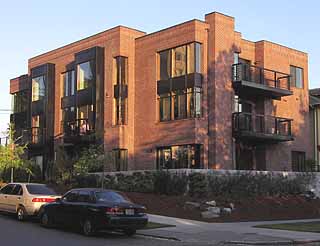
DJC.COM
October 7, 2004
Where's the family in multifamily?
Weber + Thompson

Benotto
|
But a closer look at the type of housing being built in higher density areas reveals that apartments and condos are nearly exclusively designed for and populated by young singles, childless couples or empty nesters.
Where are the families?
Single-family homes on large suburban lots have been the gold standard environment for raising families and are rarely questioned as being the only option. But if we are serious about providing diverse housing for people of all incomes levels throughout their life cycle, and diminishing sprawl, then there must be a viable alternative to detached single-family. This means making multifamily housing, and the neighborhoods around them, more family-friendly.
Location, location, location

Photos courtesy Weber + Thompson
This townhouse base to a Vancouver development provides private street level stoops and outdoor spaces for neighbors to sit and keep an eye on playing children.
|
Where families choose to live is as significant as what they choose to live in. Location is mostly determined by proximity to quality schools and recreation. Many cities, such as Toronto, have kept an ample variety of urban housing by maintaining the quality and quantity of schools and parks within the heart of the city.
In downtown Seattle, most older housing is gone and the core is woefully lacking in schools and parks. Outside of downtown, many neighborhood commercial zones as well as the multi-family L zones are well located in proximity to parks and schools, are serviced by transit and are becoming local employment centers. These are prime areas for providing family-geared multifamily housing.
An upcoming opportunity to transform multifamily in Seattle is the rapidly developing South Lake Union area. The Seattle Office of Housing's report, "South Lake Union Housing," encourages a range of housing sizes and types. It also identifies family needs such as childcare, schools, churches, small grocery stores and community meeting areas. However, this report does not investigate the details of how these needs will be built, or who will pay for them.
In suburban developments, most, if not all, housing developers are required to provide mitigation fees to cover costs of schools, parks and traffic. Vancouver has brokered deals with developers for its West End that have funded schools, recreation centers, extensive parks and day-care services. Within some downtown zones, Vancouver requires 25 percent of multifamily units to be designed for families.
What is needed
Increased density in itself does not preclude families. Studies have shown no significant relationship between density and residents' satisfaction. Suitability relates more to design and amenities rather than the number of units per acre.
Multifamily housing can be a successful environment for raising children, provided the following qualities are incorporated:
This essential feature of a single-family home, when used in multifamily housing, has many benefits for kids and the community. Children under 11 play outside more when residing within a floor of the ground. Studies have shown that kids 11 or younger feel discontented living off the ground and play less.
Typical double-loaded corridor flats, located away from the street, are less suitable for children as their noise often echoes down hallways. Balconies require constant supervision for preschoolers as they have the urge to climb up and look down.
Ground-related units can easily fit into multifamily housing regardless of density. Vancouver has been successful in encouraging residential development to fill the perimeter of the block with a two- to six-story base that frames the street. These units are essentially town houses, or stacked town houses with private entrances at the street level. Towers, where density and height allows, rise from these ground-related podium bases. In other schemes, these bases are stand-alone mid-rise buildings. This pattern works everywhere retail at base is not a requirement by zoning or supported by market conditions.
Families need outdoor space, and multifamily housing does not by definition exclude this. A grade-related entrance combined with semi-private open space between the street and the entrance provides privacy for the unit, and allows for defensible space — a demarcation of territory through hedges, low rail fences or other devices to separate it from the street realm.
This provides an area close to the dwelling for young children to play within sight of an adult. A usably sized covered stoop or porch at-grade provides a place to sit and observe the street and an area for the children to play. Unfortunately, within the Seattle land use code, covered porches are counted towards coverage, rather than open space, in effect penalizing the developer for providing these amenities on small sites.
The size of the outdoor space is another concern. According to Claire Cooper Marcus and Wendy Sarkissian in their book "Housing as if People Mattered," a minimum 330 square feet of private outdoor area, connected to the dwelling, is required for families.
"Society often places a low priority on children's play," says Marcus/Sarkissian, "We cannot buy off our children by merely providing playgrounds." They state that only 20 percent of children's play happens in the playground, the rest is incidental. "Children will play anywhere and everywhere; design the site accordingly."
Children enjoy highly articulated and lively environments as much as adults do, and the urban sidewalk environment can offer this better than anywhere. Jane Jacobs is a strong proponent of the sidewalk being the primary place to assimilate children under the watchful eye of adults and for being the most flexible place for children's self-generated play.
In her book "Death and Life of American Cities," Jacobs recommends that urban sidewalks be 20 to 35 feet wide to accommodate children's play outside of the main pedestrian traffic. The sidewalk can be viewed from inside the home, by local shopkeepers and by passersby, making this the safest place for children rather than in playgrounds away from adults.
This runs counter to the usual thinking. Developers may well consider extending the typical 5- and 10-foot-wide sidewalks within higher density family housing rather than locating a tot lot out of sight.
Though most play is incidental, there is still need for direct access to communal outdoor play areas for school-age children. While outdoor play spaces should be located within perimeter block developments, older children's play requires a larger area and facilities best served at the neighborhood level.

Ground-level town homes in this Capitol Hill development, The Opal, create private areas suitable for children.
|
The need for privacy, both visual and auditory, is highly important. Units must be designed so crying babies do not disturb adjacent residents. Children's laughter should not reverberate between hard building canyons. Windows must be located so there is no direct line of sight between units. Balconies on upper floors must not directly overlook private yard space of another unit.
Family units need more bedrooms, possibly additional bathrooms and more flexibility in layout. There is also a greater need for storage within the unit for things like strollers, shopping carts, tricycles, play equipment and the like. Further, the walking distance from parking to unit should not be long or complicated.
Focus groups, as reported by Connect for Kids, have indicated other amenities that support families. Some ideas cited include an on-site concierge; children's recreation rooms adjacent to adult recreation facilities; and pay-as-used baby-sitting services or day-care. Developers can realize a marketing edge by incorporating these ideas.
Housing will not work for families unless the neighborhood created is safe and strong.
In Richard Louv's book, "How America's Families are Reviving our Neighborhoods," he writes: "If we lose a sense of community, our kids are going to grow up afraid Â… a sound family is a tremendous advantage to a child, but it's not enough. The parent has to know that when a child walks out the door, there are others who care and will create a safe environment."
Traditional design elements such as ground entrances and front stoops are considered primary ways to see and meet your neighbor and create more eyes on the street. It also enables families to take pride and ownership of their home and place in the community. In conjunction, wider sidewalks and shared open spaces encourage people to linger, providing greater opportunity to meet neighbors.
Providing a variety of dwelling types within a development ensures that as residents' space needs change, they can stay within their social network. A recent trend is people moving less and, as they stay put, working to improve the stability of their neighborhoods and create communities that grow and evolve together.
Designing for families/designing for all
In the end, higher density housing, thoughtfully designed, may prove to be a better environment for raising children due to the proximity of neighborhood support, people and services. This might not appeal to every family, but providing real choices and options in the housing marketplace benefits many residents, developers and the city as a whole.
Catherine Benotto, AIA, ASLA, LEED AP, is an architect, landscape architect and associate at Weber + Thompson where she specializes in master planning.
Other Stories:
- Tough Seattle neighborhood reinvents itself
- Here's how to get out of your car
- Let's learn about 'smart growth' — quickly
- SEED plants a legacy in Rainier Valley
- Workers get homes, with help from their bosses
- Living in a cubby hole? Make it look big
- Mixed feelings about mixed-use
- Transportation overhaul for South Lake Union
- Office space: Are we finally shrinking?
- Downtown housing has a bright future in Seattle
- A road map for cities in transition
- The three C's of urban infill
- Creative builders take on changing land rules
- Is Seattle ready for urban greensheds?
Copyright ©2009 Seattle Daily Journal and DJC.COM.
Comments? Questions? Contact us.